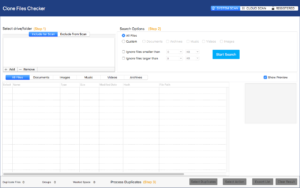There can be a hell lot of duplicate documents stored on different folders, subfolders of your MacBook. If you aren’t regularly cleaning up your Mac, chances are that these files have already started affecting the performance, stability and functioning of your Mac OS.
Fortunately, not everything is lost and you can take measures to fix the mess and get your Mac back to its optimum performance levels. There are a couple of ways to identify duplicate documents. We’ll discuss these methods one by one.
Product Spotlight (Duplicate Files): Use Clone Files Checker to remove 1000s of duplicate documents and files on Mac
CFC is made by our company, Sorcim Technologies. It never asks for your email address to install the software. Download and use!
Method 1: Use the Finder to Sort Documents By Name
Mac sadly doesn’t include an in-house functionality to find your duplicate files. However, you can use the Finder to sort all documents by their names. This will help you to manually compare the filenames and identify duplicates. Here are the steps:
- Click the Finder icon on the Dock.
- Click File and now select New Smart Folder.
- Click on the Add button (plus sign) on the top right corner of your screen to open up a New Smart Folder tab.
- Now click the plus sign just next to Save (just below the plus sign you clicked in step # 3).
- Set the first drop-down box to Kind.
- Set the second drop-down box to Document to search specifically for duplicate documents. To search for other file types, you can use Image for picture files, Movies for videos, etc.
- Optionally, in the third drop-down box, select a document file extension to further narrow down your search. This is not recommended if you wish to perform a broader search that consists of all document formats.
- Again, click the Add button (plus sign) icon on the upper right. This will add another row to configure more search parameters.
- In the newly added row, set the first drop-down box to Name.
- Set the second drop-down box to Contains.
- Set the textbox value to any file name you want to search for. For example, new year.
- This will show up all documents that contain the phrase new year in their filename.
As you might have noticed, this procedure is quite confusing and time-consuming. Also, there is a higher possibility of false positives and accidentally deleting your original files. This may not be a feasible approach for businesses and organizations that have limited time with so many files and data to compare.
So we will jump to a method that does the job of finding and deleting duplicate documents with minimal human intervention, in a speedy manner.
Method 2: Automatically Find & Delete Duplicates (Recommended)
Clone Files Checker for Mac is a specialized tool that searches your MacBook for duplicate files. You can employ a full-fledged duplicate scan to search for all sorts of files, or perform custom scan depending on the file types you want to search for. Thanks to the use of modern scan algorithms, CFC offers 100% accuracy and simplifies the entire scan process. Files that share the exact Hash Code are grouped together, while those with unique hash codes are considered as non-duplicates and filtered out of the results.

Some prominent features of Clone Files Checker for Mac are given below:
- Find duplicate documents, pictures, music, videos and archives
- Cloud Scan feature gives you access to the Web-based Cloud Duplicate Finder tool to automatically search for duplicates on Microsoft OneDrive, Google Drive and Dropbox
- Option to move duplicates to a new folder, instead of deleting altogether
- Apply file size filters to set a minimum and maximum scan limit. This option is very helpful to exclude very large files that can potentially increase the scan time and most likely, won’t be identical in nature
- The in-house file preview feature allows you to view image preview without the need to open a file outside
- Different file selection criteria. You can automatically select newest files in each group, oldest files in each group, least modified files in each group, files located in a specific directory, etc
- Choose if you want to simply purge the duplicates or move them to a folder